There are 25 different types of turtles in Virginia. If you are a turtle lover who lives in Virginia, you might be wondering what types of turtles are available in your area!
Since all turtles have different needs, temperaments, and appearances, you might want to find out which will best suit you.
The variety of turtle species in Virginia demonstrates the state’s diverse range of turtles. However, issues such as climate change and the pet trade continue to pose threats to these wild animals.
Virginia is home to 20 native species like the common musk turtle, spiny softshell, pond sliders and the diamond-backed terrapin, as well as several species of sea turtles, making it a significant region in the United States for turtle diversity.
Before you go trying to find these turtles in the wild and taking them out of their natural habitat, we recommend you check our adoptions page first for people giving up their turtle.
Taking turtles or tortoises from the wild is bad for everyone since wild caught may have parasites or diseases, and then there is the side of caging up a wild animal.
Note that not all turtles listed here are legal to own in the State of Virginia as pets and some are illegal in general to own.
Be sure to check your local laws before considering adopting or buying any pets to ensure you are in compliance and not breaking any laws.
Now let’s get into it. Here are some of the breeds of turtles in Virginia. Some may be good pet options, while others like sea turtles are just cool to look at.
Table of Contents
Types of Turtles in Virginia
These turtles of Virginia include a variety of habitats, ranging from freshwater to the open ocean, making the state a rich ground for studying turtle species.
1. Spotted Turtle
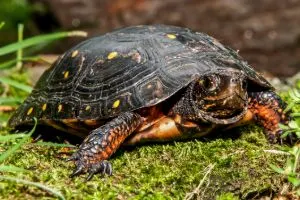
- Experience Level: Intermediate to Expert
- Family: Emydidae
- Scientific Name: Clemmys Guttata
- Adult Size: 4 to 5 inches
- Lifespan: 25 to 50 years
- Average Price Range: $75 to $100
- Recommended Books: BASICS – Ecology, Husbandry & Breeding Spotted & Wood Turtles by Andreas S. Hennig
These turtles are one of the smallest semi-aquatic species that are kept as pets, which makes them attractive to turtle lovers.
They also live for a long time and can be great to have, but with any semi-aquatic turtle comes specific housing needs and a particular diet.
These turtles can usually be identified by their distinctive white or yellow spots. Their habitat typically includes shallow waters where they feed on small fish and other small animals, showcasing their powerful jaws in action.
Their shells are usually black and they will either have light yellow or red undersides. Female spotted turtles will have a reddish chin, whereas males will have a black one.
Spotted turtles are omnivorous and will consume anything from insects like worms, slugs, and snails to fruits like melon or vegetables like butter lettuce. You can also see them feeding on algae, soft aquatic plants, and even water lily seeds.
Spotted turtles are active and curious, but can get stressed out when handled. It’s best just to observe and enjoy your spotted turtle.
For more see our page about the Spotted Turtle.
2. Eastern Chicken Turtle

- Experience Level: Intermediate
- Family: Emydidae
- Scientific Name: Deirochelys reticularia reticularia
- Common Names: Chicken turtle
- Adult Size: 4 to 6 inches
- Lifespan: 20 to 24 years
- Average Price Range: $50 to $75
Eastern chicken turtles get their name because, apparently, their meat tastes like chicken! It was, at some point, a popular meat in southern markets.
These timid, yet alert turtles can live in an enclosure with other Chicken turtles. You might even see them basking together.
They spend most of their time in water and will eat aquatic insects, amphibian larvae, and smaller fish like crayfish.
One of the most concerning threats to these native species is habitat loss. Turtles in Virginia Beach, for instance, face challenges due to habitat degradation, especially during nesting season in late summer.
3. Wood Turtle
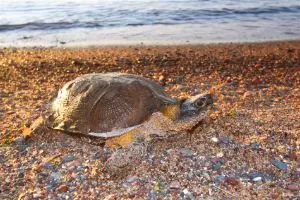
- Experience Level: Beginner
- Family: Emydidae
- Scientific Name: Glyptemys insculpta
- Common Names: Wood turtle or North American wood turtle
- Adult Size: 7 to 8 inches
- Lifespan: 40 to 58 years
Wood turtles in Virginia are protected by the state and the sale or importation of any native or naturalized species of them is also illegal under VAC 15-30-10.
They are identified by their red and black body and their olive-green, black or pale-yellow carapace with dark brown linings. They have a mostly yellow plastron with black blotches along the bridge and outer edges.
Since they dwell on both land and water, they accept a wide variety of foods, eating an omnivorous diet. They will eat live foods like snails, slugs, tadpoles, and even sometimes fish or mice. They will also feed on berries, mushrooms, and fruit.
For more see our page about Wood Turtles.
4. Bog Turtle

- Experience Level: Beginner
- Family: Emydidae
- Scientific Name: Glyptemys muhlenbergii
- Common Names: Muhlenberg’s Turtle
- Adult Size: 3.5 to 5 inches
- Lifespan: 40 years
These semi-aquatic turtles are known to be one of the smallest turtles in North America! They are, on average, an adorable 4 inches long.
They’re a very dark olive-green or black in color and will usually showcase a bright red, orange, or yellow blotch on each side of its head.
Bog turtles are omnivorous and will typically feed on insects, snails, slugs, worms, small rodents, nestling birds, frogs, or berries and grains.
They like to live in soft areas and love to find hiding spots in hollow woods. Make sure to give them some nice, dry shrubbery, some compost, and leaves to sleep on with a comfortable space for their tiny bodies.
These guys are known to recognize their owners and even come out for food or greet you when you feed them. Their little beady eyes and their small size makes them a really attractive pet.
The Bog turtle is a fedarally protected species and is not to be owned as a pet.
Painted Turtles
5. Eastern Painted Turtle

- Experience Level: Beginner
- Family: Emydidae
- Scientific Name: Chrysemys picta
- Adult Size: 4 to 10 inches
- Lifespan: 30 to 40 years
- Average Price Range: Between $20 to $50
- Recommended Books: Painted Turtle Pet Owners Guide by Ben Team
This subspecies of the Painted Turtle breed is small and easy to keep in both indoor or outdoor enclosures making them very beginner-friendly! These small, oval-shaped breeds have a flattened, smooth, dark olive or sometimes black shell with a slight height to the center of the carapace.
They’re great swimmers that will need at least 10 gallons of filtered water to themselves. They are also very easy to feed since they accept both plant and animal-based foods. They will even eat lettuce, parsley, and apples.
The Virginia Department of Wildlife Resources emphasizes the importance of conserving these turtles, especially as they move through their home range in early fall.
For more on their care, diet, and environmental needs check out the Eastern Painted turtle care sheet.
Slider Turtles
6. Cumberland Slider

- Experience Level: Beginner
- Family: Emydidae
- Scientific Name: Trachemys scripta troostii
- Adult Size: 5 to 10 inches (Depending on gender)
- Lifespan: 40 to 50 years
- Average Price Range: $20 to $30
- Recommended Books: Aquatic Turtles: Sliders, Cooters, Painted, and Map Turtles by R.D. Bartlett
Cumberland Sliders are omnivorous and can live on a combination of commercial turtle pellets, but will need you to supplement them with leafy green vegetables like collard greens or romaine lettuce as well as protein sources from mealworms and crickets.
They are friendly turtles, which makes them attractive pets. They can grow a good size, are active, and are more accustomed to handling than other species of turtles, especially when they’re small. They are also social and you might see them basking together in the wild.
The Cumberland slider is related to the Yellow-bellied and Red-eared sliders, meaning they pretty much have the same care requirements.
The Cumberland slider might not have colored markings as prominent as their siblings, they can be identified by their olive-brown color and yellow markings on their carapace.
They are very good swimmers and can be found in quiet waters with nice, muddy bottoms. Their enclosure needs a water temperature of about 70 to 75°F and a basking area of 90°F.
For more see our page about the Cumberland Slider.
7. Red-eared Slider
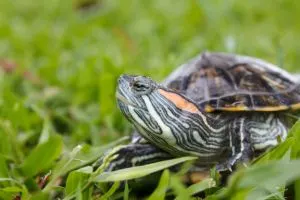
- Experience Level: Beginner
- Family: Emydidae
- Scientific Name: Trachemys scripta elegans
- Common Names: Slider Turtle, Red-eared Turtle, Red-eared Terrapin, Red-eared Slider Turtle
- Adult Size: 6 to 8 inches
- Lifespan: 20 to 40 years
- Average Price Range: $15 to $50
- Recommended Books: Red-eared Slider Turtle Owners Manual by David Donalton
Fun fact time: Leonardo from the Teenage Mutant Ninja Turtles is supposed to be a Red-eared Slider.
This aquatic turtle is a great swimmer and will need a lot of space to do so; the bigger the turtle, the bigger the tank. Check out our turtle tank setup guide for more on tank sizes.
They can be identified by their bright yellow stripes and a signature patch of red just behind their eyes. It is also, however, not uncommon to find some red-eared sliders without this patch.
They have webbed feet that are perfect for maneuvering around in the water. Red-eared sliders are carnivorous while young but shift to an omnivorous diet as they grow into adulthood.
When feeding your pet slider, you will want to give it a diet that is basically half vegetation with leafy greens, green beans, or carrots. You also want to feed them a 25% commercial diet, with the other quarter being animal protein.
A commercial diet will consist of turtle pellets or trout chow, whereas animal protein can be anything from live feeder fish, earthworms, aquatic snails, and crickets.
For more on care have a look at our in complete care guide for the red ear slider.
8. Yellow-bellied Slider

- Experience Level: Beginner
- Family: Emydidae
- Scientific Name: Trachemys scripta scripta
- Common Names: yellow-bellied terrapin
- Adult Size: 5 to 13 inches (depending on gender)
- Lifespan: 20 to 40 years
- Average Price Range: $15 to $50
- Recommended Books: Aquatic Turtles (Complete Herp Care) by David T. Kirkpatrick
These beautiful, dark olive or sometimes black turtles will have a wavy-looking design of yellow stripes throughout their body and even sometimes on their shell.
Male yellow-bellied sliders can grow up to 9 inches whereas females will grow as large as 13 inches.
They are diurnal creatures, meaning they will be active and ready to eat first thing in the morning. Their care is just like the red-eared slider care, so if you have cared for one before, it will be easy!
These turtles don’t enjoy being handled too much and may feel threatened or stressed if handled too often, which might cause them to nip at you! However, you can get them accustomed to handling. Generally, turtles do not enjoy being picked up or petted.
For more see our page about the yellow belly slider.
Cooters
9. Eastern River Cooter
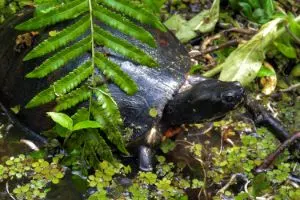
- Experience Level: Beginner to Intermediate
- Family: Emydidae
- Scientific Name: Pseudemys Concinna Concinna
- Common Names: River cooter
- Adult Size: 12 inches
- Lifespan: 40 years
- Average Price Range: $20 to $50
- Recommended Books: Aquatic Turtles: Sliders, Cooters, Painted, and Map Turtles by R.D. Bartlett
The Eastern River cooter can be identified by their broad, dark greenish to brown carapace. They will also usually come with multiple yellow stripes on their head.
These cooters can be found in freshwater with a gentle current and heavy vegetation, where they like to swim and hide underwater for hours on end.
While you can sometimes catch them basking in the sunlight, if you approach them, they will quickly retreat back into the water.
Eastern river cooters can grow to be very large so you want to make sure you have the space for these guys.
Their size may seem doable at the beginning, but you need to make sure you are committed to raising a large turtle if you’re thinking about getting a cooter.
These cooters will mostly have a diet of aquatic plants such as macrophytes and algae.
Usually, a diet of aquatic vegetation will suffice for adult Easter river cooters, but younger ones might seek some protein from any invertebrates, crustaceans, and sometimes fish.
For more see our page about the Eastern River Cooter.
10. Coastal Plain Cooter

- Experience Level: Beginner to Intermediate
- Family: Emydidae
- Scientific Name: Pseudemys concinna floridana
- Common Names: Coastal plain cooter, Florida cooter, pond cooter
- Adult Size: 15.6 inches max
- Lifespan: 40 years+
- Average Price Range: $20 to $50
- Recommended Books: Aquatic Turtles: Sliders, Cooters, Painted, and Map Turtles by R.D. Bartlett
The Coastal Plain Cooter can be identified by their smooth, dark brown-olive carapace, their pale-yellow underbellies, and their yellow-striped heads.
These herbivorous freshwater turtles feed on aquatic vegetation and love basking. You can find them roaming still waters like marshes, ponds, and wetlands.
They are quite social turtles, as they can be seen basking together in groups. They are good swimmers and avid baskers so if you’re planning to keep one, you’ll want a deep-water aquarium with a good spot for basking under a light.
A healthy temperature for these cooters should be a water temperature of 75°F and a basking spot of 85°F.
A 100-gallon tank should be a good amount, at the very least, since these turtles constantly swim and can grow to be quite large in size.
Although they can be omnivores if the opportunity arrives and an unlucky invertebrate becomes their prey, but it is more common in the male cooters than the females.
11. Northern Red-bellied Cooter

- Experience Level: Beginner to Intermediate
- Family: Emydidae
- Scientific Name: Pseudemys rubriventris
- Common Names: American red-bellied turtle
- Adult Size: 8 to 12.5 inches (depending on gender)
- Lifespan: 40 to 55 years
- Average Price Range: $30 to $90
- Recommended Books: Aquatic Turtles: Sliders, Cooters, Painted, and Map Turtles by R.D. Bartlett
These beauties are the largest pond turtles to inhabit North America. They are also the most commonly seen turtle breeds that are kept as pets.
They can be identified by their beautiful red undersides, which is how they got their name.
These guys have a mild temperament, although they have been seen to grow a little aggressive around food or when feeling threatened.
When they first arrive at their new home, they may shy away into their shell for a few days, but at some point, will grow comfortable enough to greet you when you feed them.
Box turtles
12. Eastern Box Turtle
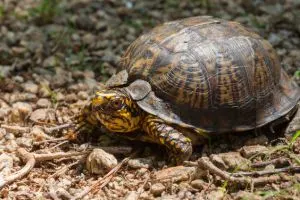
- Experience Level: Beginner
- Family: Emydidae
- Scientific Name: Terrapene carolina carolina
- Adult Size: 4.33 to 7 inches
- Lifespan: 40 years
- Average Price Range: $120 to $400
- Recommended Books: Box Turtles (Complete Herp Care) by Tess Cook
These land turtles prefer a humid environment of at least 70% humidity. You will want to get some bedding that will promote high humidity and also place a small pool of water in their enclosure.
If you want to raise your turtle outside, make sure that their enclosure is around 4 by 4 feet long and stays humid enough for them to be comfortable.
They are identified by beautiful yellow, spotty coloring, and a high-domed, rounded shell. Their vivid markings and unique shape are something you just can’t miss.
They make great pets because they are highly adaptable, are docile, and easy to handle. They are also very slow movers that don’t bite and they are known to be Virginia’s only terrestrial turtle.
For more see our page about the Eastern Box Turtle.
Snapping turtles
13. Common Snapping Turtle
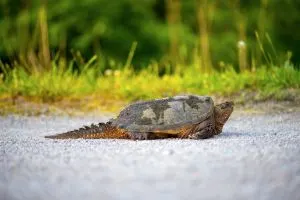
- Experience Level: Intermediate to Expert
- Family: Chelydridae
- Scientific Name: Chelydra serpentina
- Common Names: Common snapping turtle
- Adult Size: 8 to 20 inches+
- Lifespan: 30 to 50 years+
- Average Price Range: Between $20 to $40
- Recommended Books: Snapping Turtle Pet Owners Guide by Ben Team
These guys can start out pretty comfortably small at a young age, but can also quickly grow to be very large animals.
If you want one of these beauties as a pet, you will have to know your way around aggressive turtles.
Snapping turtles can usually be identified by their little beak or sharp nose. Their shell color will usually range from tan to a dark, almost-black brown. Their large size and varied diet make them fascinating subjects for study by the Virginia Herpetological Society.
Their limbs and tail show off a peek of yellow, whereas their heads will usually be a dark olive or black.
These turtles will hiss and snap if they are feeling threatened. They can be quite aggressive and are prone to snapping when being handled.
They will eat almost anything including aquatic vegetation, amphibians, freshwater fish, small mammals like birds, bloodworms, shrimps, snails, cooked lean meats, crickets, mealworms, and earthworms.
Snapping turtles barely bask, but they will float up to the surface of the water to warm up, so you will still want to have a UV light available for them to do their own version of “basking” in.
Snapping turtles may not be the most cuddly pets, but they are fascinating and fun to observe for anyone who has more experience handling and caring for more aggressive, territorial turtles.
For more see our page about the Common Snapping Turtle.
Softshell turtles
14. Eastern Spiny Softshell
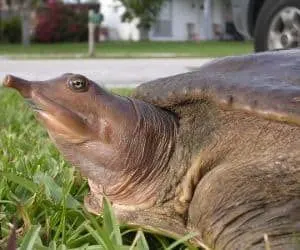
- Experience Level: Intermediate to Expert
- Family: Trionychidae
- Scientific Name: Trionyx spiniferus
- Adult Size: 5 to 9 inches for males; 9 to 11 inches for females
- Lifespan: 50 years
- Average Price Range: $20 to $50
- Recommended Books: Spiny Softshell Turtle by Dr. Daniel Robinson
This aquatic turtle lacks what most turtles have: a hard shell. This makes them more susceptible to getting attacked in the wild.
These turtles will be a little more high-maintenance than most due to their lack of a shell. Their soft shell can be wounded by sharp objects, even just inside their own tank.
These guys are really cool and prehistoric-looking with their little tentacle-shaped beak of a nose and their smooth, brown, or olive-green body.
Some have little spots on their shell and sometimes they will show yellow linings on their undersides.
In the wild, they will keep themselves submerged in water, sand, or mud in order to hide from predators. This means you will want to give your softshell baby a good sandy or muddy place to hide in order for them to feel comfortable.
You should keep your tank clean because they like clean water since they will be in it most of the time and get their oxygen from it with their special “gills”.
These guys will eat whatever they would be able to catch in the wild. This includes any fish, small crabs, snails, amphibians, and even small birds sometimes.
For more see our page about the Eastern Spiny Softshell.
Map turtles
15. Northern Map Turtle
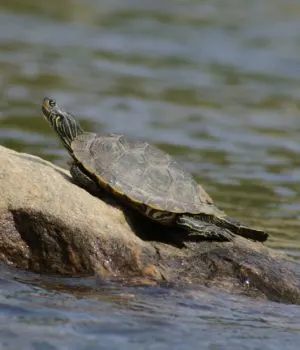
- Experience Level: Beginner
- Family: Emydidae
- Scientific Name: Graptemys geographica
- Adult Size: 4 to 10.5 inches (Depending on Gender)
- Lifespan: 15 to 20 years
- Average Price Range: $20 to $60
- Recommended Books: The Map Turtle and Sawback Atlas by Peter V. Lindeman
Northern map turtles get their name from their dark markings on their olive-green shell, which resemble the contours on maps or charts. Their bodies may also have almost topographic-like, bright yellow stripes.
They’re known to be active swimmers and avid baskers, meaning you will want to give them plenty of room to swim and some logs or rocks for them to comfortably bask on.
These omnivores can thrive on a commercial diet of aquatic turtle food, but they will also eat insects and leafy greens. Females have larger, stronger jaws which allow them to consume mollusks like snails and even clams or crayfish.
Northern map turtles are fun to watch and own, especially if you don’t want turtles that grow as big as sliders or cooters do.
Although these turtles can stay a relatively good size, they will need a large aquarium to swim and bask comfortably.
They are also very shy pets. Once they associate you with food, they will become more friendly. They might even beg you for food and greet you during feeding time.
If you get your Map turtle as a hatchling, that is also a good way to allow them to grow more used to you.
For more see our page about the Northern Map Turtle.
Mud turtles
16. Three Striped Mud Turtle

- Experience Level: Beginner
- Family: Kinosternidae
- Scientific Name: Kinosternon Baurii
- Adult Size: 4 to 5 inches
- Lifespan: 50 years
- Average Price Range:
These tiny aquatic turtles love to roam the bottom of waterbeds. They prefer still or slow-moving bodies of water since they rarely come out.
They will hardly ever bask and spend most of their time walking underwater. You will usually see them at the bottom of shallow ponds or buried under leaves.
Striped mud turtles get their names from the three tan or pale-yellow stripes that run lengthwise across their shell.
Some may even have a few strips on their face or body, which is usually dark brown or black in color.
They are omnivorous and will eat anything from algae or plants to fish, insects, and snails.
These guys may be tiny and cute but don’t assume that means they’re docile.
Striped mud turtles are easily threatened and aren’t afraid to defend themselves with their sharp beak-like mouths.
For more see our page about the Striped Mud Turtle.
17. Southeastern Mud Turtle

- Experience Level: Beginner
- Family: Kinosternidae
- Scientific Name: Kinosternon subrubrum subrubrum
- Adult Size: 3 to 5 inches
- Lifespan: 50 years
- Average Price Range: $40 to $100
This freshwater turtle also likes slow-moving or still water, just like its previous sibling, the striped mud turtle.
Because mud turtles are so tiny and low-maintenance, they can happily live in a terrarium, as long as you are giving them everything they need.
They don’t really swim, but rather like to walk around and will hardly be seen basking.
12 inches of water should be good enough for this little guy as long as you’re providing them places to hide.
This tiny turtle has a smooth, dark shell that’s usually a dark olive-brown without any markings on it. Sometimes their plastron may be yellow with black blotches on it.
These omnivorous turtles enjoy eating water lily seeds and crustaceans like crayfish. They eat insects, mollusks, amphibians, and also aquatic vegetation.
Similar to the striped mud turtle, these guys can be feisty if kept in an enclosure with other turtles. They could even kill one another.
Males can get territorial and might even attack an unreceptive female.
Check out the following page to learn more about Mud Turtles.
Diamondback terrapins
18. Northern Diamondback Terrapin

- Experience Level: Beginner to Intermediate
- Family: Emydidae
- Scientific Name: Malaclemys terrapin
- Common Names: Diamondback turtle
- Adult Size: 4 to 5.5 inches
- Lifespan: about 25 to 40 years
- Average Price Range: $250 to $300
- Recommended Books: Map Turtles and Diamondback Terrapins by W.P. Mara
These aquatic reptiles reside in brackish waters like shallow bays and tidal creeks. They are a little tougher to find in the wild and can be very anxious and stressed turtles.
The stress caused by captivity can actually bring them many health problems. They are actually illegal to own in many places. Learn more about turtle laws here.
These terrapins can be identified by their raised diamond-shaped markings on the highest point of their carapace, which can range in color from a dark grey to almost black.
Their skin will usually appear at about the same color but it will sometimes be lighter. On their bodies, you will find dark blotches or spots that make them look really unique.
If you do decide to keep one, you will want to add salt to your enclosure since they live in brackish, swampy waters with higher salinity. The optimal pH level for Diamondbacks is around 6.8 to 7.0.
They prefer a water temperature of about 76 to 78°F. They also love basking, so make sure to give them a good basking spot of about 90°F.
They are not hard to care for and aren’t very aggressive, even when stressed out. Unfortunately, their meat had become a delicacy in some places, causing them to be hunted almost to extinction.
For more see our page about Diamondback Terrapins.
Musk turtles
19. Stripe-necked Musk Turtle

- Experience Level: Intermediate
- Family: Kinosternidae
- Scientific Name: Sternotherus minor peltifer
- Common Names: Loggerhead Musk Turtle
- Adult Size: 3 to 4.5 inches
- Lifespan: About 50 years+
- Average Price Range: $20 to $60
These fast-moving, quick-nipping reptiles can be easily confused by their sibling, the Loggerhead musk turtle because the Stripe-necked musks are a subspecies of the Loggerhead.
Because they can be found in similar areas, you can differentiate them by the yellow stripes on their neck, as their name suggests, as well as the shapes of their heads.
You may see these two grouped together since they are subspecies, but caring for them is pretty much the same so that’s ok.
These turtles are mainly carnivorous, feeding on crayfish, mollusks, and aquatic insects, but they will also sometimes eat plants.
They are known to be very messy eaters, so you’ll want to have a high-quality filtration system for them in their enclosure.
They enjoy a basking temperature of about the mid-80s to a low 90 degrees Fahrenheit. They are an aquatic turtle, so they will mostly be in the water.
Musk turtles will release a foul-smelling secretion when they are highly stressed or threatened as a defense mechanism so that is something to keep in mind if you are thinking of owning a musk turtle.
20. Eastern Musk Turtle
- Experience Level: Intermediate
- Family: Kinosternidae
- Scientific Name: Sternotherus odoratus
- Adult Size: 4 to 5 inches
- Lifespan: 50 years +
- Average Price Range: between $20 to $70
This small turtle goes by many times like the “Stinkpot turtle”, a name that contains the word “musk”, and even its scientific name has the word “odor” in it.
These musk turtles can release a “musky”, strong odor from their scent glands, which is used to deter predators. The odor has been described as “skunk-like” by some.
If you don’t mind the smell, they could make a great pet. They are small in size, aren’t too hard to care for, and are actually really cool looking.
If not by their stench, they can be identified by their narrow, highly-arched or domed, blackish-brown shell and body.
They will also have a signature yellow or light-yellow stripe right behind their eyes on their head.
These musk turtles are primarily carnivorous who like to eat leeches, mollusks, larval as well as adult insects, and also tadpoles.
You may not see them wanting to leave the water a lot, but a good basking point of 80 degrees Fahrenheit should still be an option available to them.
Sea Turtles in Virginia
Virginia’s coastal areas, particularly near the Atlantic Ocean, are critical nesting grounds for sea turtles like loggerhead turtles and Kemp’s ridleys. These turtles travel great distances and can often be entangled in fishing nets, highlighting the need for marine conservation efforts.
In late spring, when the water temperatures rise, up to 10,000 sea turtles will come into the Chesapeake Bay to feed.
Most of them will be loggerheads or Kemp’s Ridley sea turtles, but sometimes there will be green sea turtles and leatherback sea turtles. The hawksbill sea turtle has been spotted straying to the Bay a couple of times as well.
You will find that the most common sea turtles that are kept as pets are green sea turtles since they are undemanding and easier to raise than most breeds.
However, none of these turtles should be kept in an enclosure they are protected under the Endangered Species Act and also thrive in the large, open space of the ocean.
They play an important role in ocean ecosystems since they maintain healthy seagrass beds using their excretion as fertilizer.
They also transport many needed nutrients from beaches and coastal dunes to coral reefs, which provides habitats for other marine life.
Their important role helps food webs stay balanced, which is a huge part of ocean life. We need to protect them at all costs.
If you are hoping to spot these beauties out in the wild, here are some facts about each that might help you identify them.
21. Loggerhead Sea Turtle

- Family: Cheloniidae
- Scientific Name: Caretta caretta
- Adult Size: between 35 inches and 3 feet
- Weight: 154 pounds
- Lifespan: 70 to 80 years
- Conservation Status: Endangered
- Habitat: Shallow, subtropical coastal regions
- Recommended Books:
- Clutch Size: 100 to 125 eggs; nesting 4 to 5 times per season
- Food: Carnivorous; they will eat clams, conches, and crabs.
- Appearance: Hard-shelled turtles with a reddish-brown color, a yellow underbelly, and long flippers. They have a large head with a defined jaw.
For more see our page about the Loggerhead Sea Turtle.
22. Kemp’s Ridley Sea Turtle

- Family: Cheloniidae
- Scientific Name: Lepidochelys Kempii
- Adult Size: About 25 inches
- Weight:77 to 100 pounds
- Lifespan: 30 years
- Conservation Status: Critically endangered
- Habitat: Shallow muddy or sandy coastal lines
- Clutch Size: 100 to 110 eggs; nesting 2 to 3 times per season
- Food: They love crabs, especially blue crabs, but will also eat shrimps, clams, and mussels
- Appearance: Triangular head with a slightly hooked beak, greyish-green, circular carapace with a light yellow or cream plastron. Their undersides may also be a pale yellow to cream color.
For more see our page about the Kemp’s Ridley Sea Turtle.
23. Green Sea Turtle

- Family: Cheloniidae
- Scientific Name: Chelonia Mydas
- Adult Size: 3 to 4 feet
- Weight: 300 to 400 pounds
- Lifespan: 80 to 100 years
- Conservation Status: Endangered
- Habitat: Tropical and subtropical waters in bays and shores by the coastline; anywhere with seagrass beds
- Clutch Size: 110 to 115 eggs; Nesting 2 to 5 times per season
- Food: Primarily herbivorous, eating seagrass and seaweed, sometimes algae. Sometimes younger green sea turtles will feed on worms, aquatic insects or small crustacean.
- Appearance: They have nonretractable, small heads and a heart-shaped, brown carapace. They will wear a greenish hue on their scaly skin, will have a cream-colored underside, and beady eyes.
For more see our page about the Green Sea Turtle.
24. Leatherback Sea Turtle

- Family: Dermochelyidea
- Scientific Name: Dermochelys Coriacea
- Adult Size: About 6 to 7 feet
- Weight: Between 1200 and 1450 pounds
- Lifespan: 30 years
- Conservation Status: Vulnerable
- Habitat: They like warm waters and can be found in every ocean except the Arctic. They will inhabit calm, shallow lagoons or bays. They love to nest on sand, sloped beaches with good vegetation.
- Clutch Size: 100 to 110 eggs.
- Food: Mainly jellyfish but sometimes some fish and other marine creatures.
- Appearance: It is the only sea turtle that lacks a hard shell, which is dark grey to black in color, sometimes showcasing scattered white spots or blotches. Their dark carapace is elongated and flexible with long ridges running down its length.
For more see our page about the Leatherback Sea Turtle.
25. Hawksbill Sea Turtle

- Family: Cheloniidae
- Scientific Name: Eretmochelys Imbricata
- Adult Size: 30 to 35 inches
- Weight: between 100 to 155 pounds
- Lifespan: About 30 to 50 years
- Conservation Status: Critically Endangered
- Habitat: Tropical, rocky waters, mangroves, lagoons, or near tropical coral reefs.
- Clutch Size: Anything from 140 to 200 eggs; Nesting about 4 times each season or every 2 weeks
- Food: Omnivorous; They will feed on sea urchins, jellyfish, mollusks, marine algae, and sponges.
- Appearance: They get their name from their unique beak-like mouths, which is similar to a hawk. They will show off an elongated, oval-shaped, amber-colored, shell that has unique patterns on it. Their also amber flippers have claws at the “elbows” of them as well.
For more see our page about the Hawksbill Sea Turtle.
Conclusion
Whether you’re looking for a pet turtle of your own or just want to take your binoculars out for some turtle spotting by the bay, there are so many different types and breeds you might be interested in learning about.
Virginia boasts some beautiful species of turtles that are easily found here. We also have the privilege of getting to see some awesome sea turtles roaming around every once in a while.
We hope that you will enjoy your time searching for different turtles or even just admiring your new pet turtle for the many years you will have it.
The best way to enjoy and respect these creatures is by observing them in their natural habitats, whether they’re terrestrial turtles in the forests or the largest sea turtles in the open ocean.
Happy Herping and if you’re a fellow Virginian who loves turtles, leave a comment below on which turtle you want or tell us about the turtle you currently have!
Other nearby states
- Turtles in Delaware
- Turtles in Maryland
- Turtles in North Carolina
- Turtles in Tennessee
- Turtles in West Virginia
